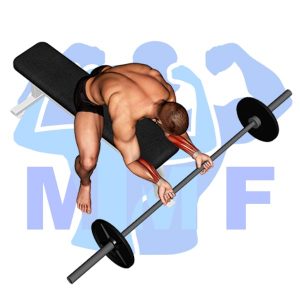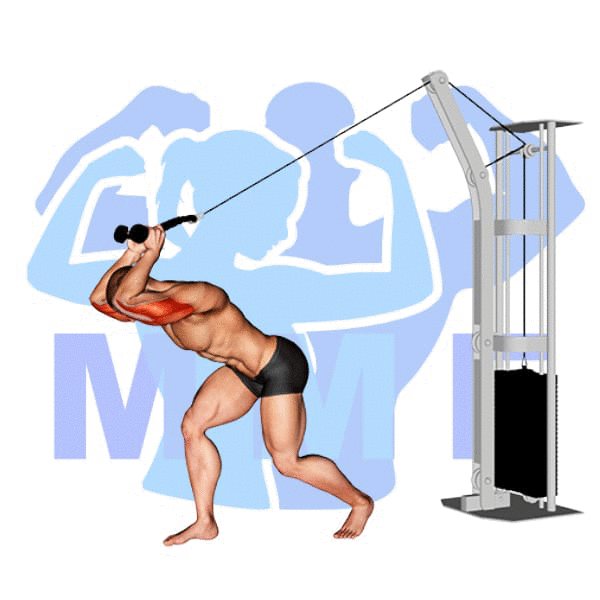Do you struggle with wrist and forearm strength during your workouts? Does your grip frequently give out when lifting heavy weights, causing your form to suffer? If so, you’re not alone. Many fitness enthusiasts experience this same frustration, especially during exercises like the barbell reverse curl. The repetitive motion of lifting weights can take a toll on your wrists and forearms, causing them to weaken over time. But don’t worry, there’s a solution. In this blog post, we’ll dive into everything you need to know about the barbell reverse curl, and share tips and techniques to help you improve your wrist and forearm strength to achieve better results in your workouts.
Barbell Reverse Curl Summary
- Primary Muscles: Wrist Extensors
- Secondary Muscles: Biceps Brachii
- Equipment: Barbell
- Mechanics Type: Isolation
- Force: Pull
- Utility: Auxiliary

Barbell Reverse Curl Instructions
- Grab the bar with a shoulder-width overhand grip thumbs toward each other.
- Keeping your elbows locked at your side, and curl the bar up to your chest.
- Contract your biceps at the top.
- Then finish by lower the bar back down to your waist.
- Repeat to complete your desired number of reps.
Video Tutorial
Barbell Reverse Curl Muscles
Target (Agonist)
- Wrist Extensors
Synergists
Dynamic Stabilizers
- None
Stabilizers
- No Significant Stabilizers
Antagonist Stabilizers
- None

Benefits of Barbell Reverse Curl
The barbell reverse curl is an excellent exercise for strengthening the wrist extensors, which are responsible for extending the wrist. This exercise helps to develop grip strength and stability of the wrist joint, as well as increasing forearm size and strength. By performing this exercise regularly, you can improve your grip and wrist strength, which can help you perform other exercises more efficiently and reduce the risk of injury. Additionally, this exercise can also help to improve coordination and balance in your upper body.
Tips for Performing Barbell Reverse Curl
The Barbell Reverse Curl is a great exercise to help you build upper arm strength and size. To make the most of your time and get the most out of your workout, here are some important tips to keep in mind.
- Inhale When You Stretch Your Muscle Tissues And Breathe Out When You Contract Your Muscle.
- Complete Power Sets. Is performing a set of not one but two unique lifts consecutive. Now there are a couple of key options to do power sets, primary is to target an individual muscle. The second is to emphasize the opposite muscle groups.
- Make certain you have warmed up your muscles before you start lifting.
- Focus On Your Breathing. With this and most exercise movements, breathing is critical. You should be breathing out during your target muscle constriction and inhaling when your target muscle group is relaxing.
Benefits and Tips Video
Frequent Mistakes To Avoid
It’s important to remember that proper technique is key when performing the Barbell Reverse Curl. If done incorrectly, the exercise could be ineffective and cause injury. To ensure you get the most out of your Barbell Reverse Curl workout, make sure to avoid the following mistakes.
- Avoid The Urge To Omit Recovery Times. Over-training may actually help make you weaker in lieu bigger.
- Don’t use To Little or Too Much Resistance. Too little, and you will not be sufficiently employing your main muscles, excess, and you will probably cheat. Ensure that you focus on your form.
- You Must Not Trai Solo. Your companion might be an amazing motivator. A partner can certainly be helpful spotter.
Find More Barbell Exercises Here
Variations and Complementary Exercises
If you’re looking for other exercises to add to your routine that are similar to the Barbell Reverse Curl, here are a few variations, complementary, or alternative exercises that work similar muscles:
Wrist Roller Forearms

The Wrist Roller Forearms exercise is a great alternative or complementary exercise for the Barbell Reverse Curl. This exercise targets the forearm muscles and also helps to improve grip strength. The Wrist Roller Forearms exercise is done by gripping a barbell with both hands, palms facing downward. You then roll the barbell up and down, focusing on the forearm muscles. This exercise is great for strengthening the forearms and improving grip strength, making it an ideal complement or alternative to the Barbell Reverse Curl.
Standing Dumbbell Zottman Preacher Curl

The Standing Dumbbell Zottman Preacher Curl is a great complementary or alternative exercise to the Barbell Reverse Curl. This exercise targets the same muscles as the Barbell Reverse Curl, but with slightly different angles of movement. It also puts much less strain on the wrists and elbows, making it an excellent choice for those with wrist or elbow issues. The Standing Dumbbell Zottman Preacher Curl forces the arms to move through a full range of motion, strengthening both the biceps and forearms. It also allows for greater individual muscle control and stabilization, which can help improve overall strength.
Seated Dumbbell Revers Grip Concentration Curl

The Seated Dumbbell Revers Grip Concentration Curl is a great alternative or complementary exercise for the Barbell Reverse Curl. It is an isolated exercise that works the biceps without having to use a barbell. The seated position helps to keep the back from arching and provides stability, while the reverse grip adds an extra challenge and works the brachialis muscle which lies underneath the biceps. The emphasis of this exercise is placed on the eccentric portion of the curl, which is when the dumbbell is lowered back down to the starting position, allowing for maximum muscle tension throughout the entire range of motion.
Check Out These Top Barbell Exercises
EZ Bar Reverse Grip Preacher Curl

The EZ Bar Reverse Grip Preacher Curl is an excellent alternative or complementary exercise to the Barbell Reverse Curl. This exercise works the same muscles as the Barbell Reverse Curl but in a different way. Unlike the barbell, which targets the biceps from all angles, the EZ Bar Reverse Grip Preacher Curl focuses more on the brachialis and brachioradialis muscles. Additionally, the preacher pad helps keep your elbows in the correct position while performing the exercise, which can help you achieve better form. If you’re looking for a more challenging variation of the Barbell Reverse Curl, then the EZ Bar Reverse Grip Preacher Curl is definitely worth trying.
EZ Bar Reverse Grip Curl

The EZ Bar Reverse Grip Curl is a great complementary or alternative exercise to the Barbell Reverse Curl. It is an effective exercise that targets the brachioradialis muscles and forearms while also working the biceps. The EZ Bar Reverse Grip Curl is performed by gripping the EZ Bar with an overhand grip and curling it up towards your shoulders. This exercise can be done standing or seated, which makes it a great option for those who have limited mobility. Additionally, the EZ Bar Reverse Grip Curl allows you to use a more comfortable grip than the Barbell Reverse Curl, and provides a greater range of motion.
Dumbbell Zottman Preacher Curl

The Dumbbell Zottman Preacher Curl is a great complementary or alternative exercise to the Barbell Reverse Curl. This exercise targets the same muscles as the Barbell Reverse Curl, but with a different angle. It is performed while seated on a preacher bench and involves curling two dumbbells up towards the shoulders. To add an extra challenge, you can squeeze your biceps at the top of each curl. This exercise can help you to further strengthen and build your biceps and forearms, making it an ideal addition to your workout routine.
Find More Arms Exercises Here
Opposing Complementary Exercises
For maximum benefit, it is important to pair the Barbell Reverse Curl with exercises that target the opposite muscle groups. This will help you create a well-rounded workout routine that will build both strength and muscular endurance. Below are some exercises that complement the Barbell Reverse Curl by utilizing opposing muscle groups:
Barbell Wrist Curl

The Barbell Wrist Curl is a great complementary exercise to the Barbell Reverse Curl. This exercise focuses on the flexors of the wrist, which are the muscles on the inside of the forearm that are responsible for bending the wrist. By performing the Barbell Wrist Curl in combination with the Barbell Reverse Curl, which works the extensors of the wrist, you can effectively strengthen both sides of the forearm and maximize forearm development. The Barbell Wrist Curl is an effective exercise to develop wrist strength and is an important complement to the Barbell Reverse Curl.
Dumbbell Behind Back Finger Curl

The Dumbbell Behind Back Finger Curl is a great complementary exercise to the Barbell Reverse Curl as it targets the opposite muscle group. This exercise works the forearms and grip strength by having the user hold a dumbbell behind their back and curl their fingers up and down. This exercise works the flexors of the forearm, which are the opposing muscles to the extensors of the forearm worked in the Barbell Reverse Curl. With this combination, users can work both muscle groups for improved strength and better arm development.
Dumbbell Finger Curls

Dumbbell finger curls are an excellent complementary exercise to barbell reverse curls. They target the same muscles but from the opposite angle, strengthening the forearm and bicep muscles. The motion of the dumbbell finger curl is similar to the barbell reverse curl, but instead of using your palms to curl the weight, you use only your fingers. This helps to isolate and focus on the forearm and bicep muscles, helping to develop them further.
Stronger Forearms in No Time with Barbell Reverse Curls
If you’re looking to build stronger forearms, the barbell reverse curl is an exercise you should add to your routine. This exercise targets the muscles in your forearm that are responsible for grip strength and wrist stability. By performing barbell reverse curls regularly, you can increase the size and strength of your forearms and improve your overall grip strength. Plus, it’s a variation of the traditional bicep curl that adds some variety to your arm workouts. With proper form and consistency, you’ll notice stronger forearms in no time.
References: Wikipedia | ExRx.net | PubMed.gov | Comprehensive List of Arms Barbell Exercises




